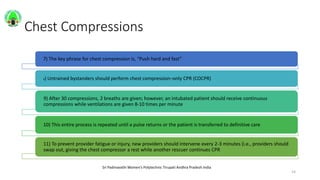Cardio Pulmonary Resuscitation - CPR HandsTraining
- 1. Cardiopulmonary Resuscitation (CPR) K V GOPINATH M Pharm PhD CPhT Sri Padmavathi Women¡¯s Polytechnic Tirupati Andhra Pradesh India
- 2. Cardiopulmonary Resuscitation ? Introduction ¨C Cardiac Arrest ? Definition of CPR ? Indications of CPR ? Equipments for CPR ? CPR Technique ? Precautions in CPR ? Pediatric CPR ? ACLS ? Conclusion 2 Sri Padmavathi Women¡¯s Polytechnic Tirupati Andhra Pradesh India
- 3. Cardiac Arrest ? Occurs when the heart malfunctions and stops beating unexpectedly ? Cardiac arrest is an ¡° Electrical ¡° problem ? It is triggered by arrhythmias ? Heart cannot pump blood to the brain, lungs and other organs ? Patient is unconscious, unresponsive, is not breathing or is only gasping ? Death occurs within minutes, if no treatment 3 Sri Padmavathi Women¡¯s Polytechnic Tirupati Andhra Pradesh India
- 4. Etiology of cardiac arrest ? Hypovalemia ? Hypoxia ? Acidosis ? Hypo / Hyperkalemia ? Hypothermia ? Hypoglycaemia ? Toxins/ Tablets ? Tamponade ? Tension pneumothorax ? Thrombosis ? Thromboembolism ? Trauma 4 Sri Padmavathi Women¡¯s Polytechnic Tirupati Andhra Pradesh India
- 5. What to do? ? Cardiac arrest can be reversible in some cases ? Call local emergency number and ? Immediately start CPR ? If available Automated External Defibrillator (AED) 5 Sri Padmavathi Women¡¯s Polytechnic Tirupati Andhra Pradesh India
- 6. Cardiopulmonary Resuscitation ? Use of chest compressions and artificial ventilation to maintain circulatory flow and oxygenation during cardiac arrest ? Early intervention help in survival and neurological outcome Sri Padmavathi Women¡¯s Polytechnic Tirupati Andhra Pradesh India 6
- 7. Compressions & Ventilations Overlapping hands placed on the center of the sternum, with the rescuer's arms extended. Chest compressions are to be delivered at a rate of at least 100 compressions per minute. Delivery of mouth-to-mouth ventilations Sri Padmavathi Women¡¯s Polytechnic Tirupati Andhra Pradesh India 7
- 8. Chest Compressions Sri Padmavathi Women¡¯s Polytechnic Tirupati Andhra Pradesh India 8
- 9. Indications of CPR ? Unconscious ? Un detectable pulse ? Undetectable respiration ? Undetectable Heart rate Sri Padmavathi Women¡¯s Polytechnic Tirupati Andhra Pradesh India 9
- 10. Equipments for CPR ? No specialized equipment ? Universal precautions- gloves, mask and gown ? Mechanical chest compressions ? A cardiac defibrillator - an electrical shock to the heart via 2 electrodes placed on the patient¡¯s torso and may restore the heart into a normal perfusing rhythm. Sri Padmavathi Women¡¯s Polytechnic Tirupati Andhra Pradesh India 10
- 11. CPR - Technique Sri Padmavathi Women¡¯s Polytechnic Tirupati Andhra Pradesh India 11
- 12. CPR initiation ? Give 30 chest compressions ? Perform the head-tilt, chin-lift maneuver to open the airway and determine if the patient is breathing ? Before beginning ventilations, look in the patient¡¯s mouth for a foreign body blocking the airway Sri Padmavathi Women¡¯s Polytechnic Tirupati Andhra Pradesh India 12
- 13. Chest Compressions 1) Place the heel of one hand on the patient¡¯s sternum and the other hand on top of the first, fingers interlaced 2) Extend the elbows and the provider leans directly over the patient 3) Press down, compressing the chest at least 2 in 4) Release the chest and allow it to recoil completely 5) The compression depth for adults should be at least 2 inches 6) The compression rate should be at least 100/min Sri Padmavathi Women¡¯s Polytechnic Tirupati Andhra Pradesh India 13
- 14. Chest Compressions 7) The key phrase for chest compression is, ¡°Push hard and fast¡± 8) Untrained bystanders should perform chest compression¨Conly CPR (COCPR) 9) After 30 compressions, 2 breaths are given; however, an intubated patient should receive continuous compressions while ventilations are given 8-10 times per minute 10) This entire process is repeated until a pulse returns or the patient is transferred to definitive care 11) To prevent provider fatigue or injury, new providers should intervene every 2-3 minutes (i.e., providers should swap out, giving the chest compressor a rest while another rescuer continues CPR Sri Padmavathi Women¡¯s Polytechnic Tirupati Andhra Pradesh India 14
- 15. Ventilation ? Pinch the patient¡¯s nostrils closed to assist with an airtight seal ? Put the mouth completely over the patient¡¯s mouth ? After 30 chest compression, give 2 breaths (the 30:2 cycle of CPR) ? Give each breath for approximately 1 second with enough force to make the patient¡¯s chest rise ? Failure to observe chest rise indicates an inadequate mouth seal or airway occlusion ? After giving the 2 breaths, resume the CPR cycle Sri Padmavathi Women¡¯s Polytechnic Tirupati Andhra Pradesh India 15
- 16. Bag-Valve-Mask Sri Padmavathi Women¡¯s Polytechnic Tirupati Andhra Pradesh India 16
- 17. Complications of CPR ? Fractures of ribs ? Fracture of the sternum ? Vomiting ? Aspiration Sri Padmavathi Women¡¯s Polytechnic Tirupati Andhra Pradesh India 17
- 18. Advance Cardiac Life Support (ACLS) ? Drug interventions ? ECG monitoring ? Defibrillation ? Invasive airway procedures Sri Padmavathi Women¡¯s Polytechnic Tirupati Andhra Pradesh India 18
- 19. Pediatric Resuscitation Sri Padmavathi Women¡¯s Polytechnic Tirupati Andhra Pradesh India 19
- 20. Conclusion ? It is a life saving technique. ? The purpose to keep oxygenated blood flow to the brain and other vital organs if the heart or lungs stop working on their own. ? The medical term for this is ¡°loss of automatic function.¡± Sri Padmavathi Women¡¯s Polytechnic Tirupati Andhra Pradesh India 20
- 21. Cardiac arrest is a leading cause of death Fast Action can save lives ¡¡ 21 Sri Padmavathi Women¡¯s Polytechnic Tirupati Andhra Pradesh India
- 22. Sri Padmavathi Women¡¯s Polytechnic Tirupati Andhra Pradesh India 22






















